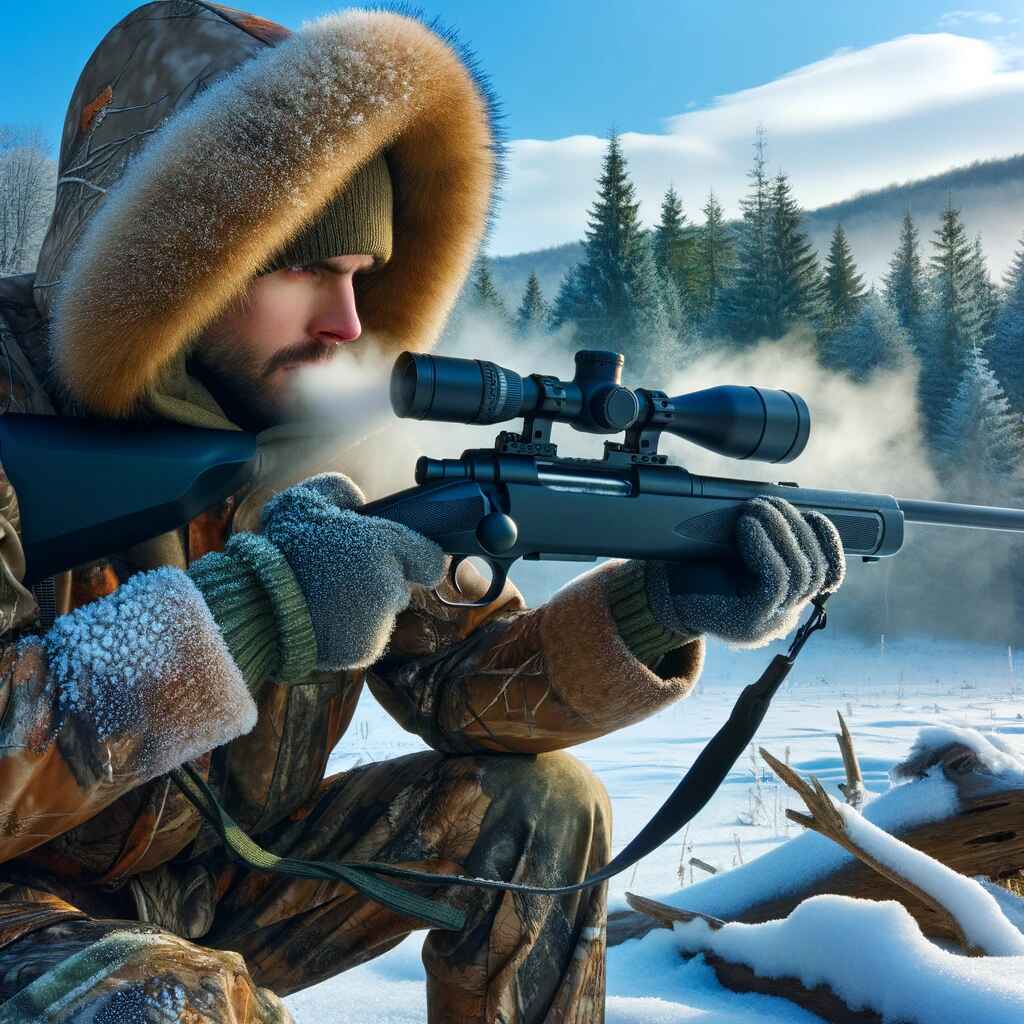As the crisp, cool air of winter sets in and snow blankets the landscape, many hunters eagerly anticipate the arrival of hunting season. However, hunting in cold weather presents unique challenges that can affect your shooting accuracy and overall hunting experience. To ensure a successful and comfortable hunting trip, it’s crucial to adjust your shooting technique to the cold weather conditions.
Let’s explore the various factors that come into play when hunting in cold weather and provide you with practical tips to help you adapt and excel in chilly hunting environments.
Understanding the Impact of Cold Weather on Shooting
Before delving into the adjustments you can make to your hunting shooting technique in cold weather, it’s essential to understand how cold temperatures can affect your performance. Cold weather can influence both your body and your firearm, leading to potential issues that need to be addressed.
1. Body Effects
a. Shivering and Muscle Tension
Cold weather can cause your muscles to contract and tense up, leading to decreased dexterity and coordination. Shivering can also affect your ability to maintain a steady aim. This physical discomfort can significantly impact your shooting accuracy.
b. Decreased Sensitivity
Cold weather can reduce the sensitivity in your fingers and extremities, making it challenging to feel the trigger or operate the safety mechanisms on your firearm. This reduced sensitivity can lead to fumbling and difficulties in handling your weapon.
c. Reduced Stamina
Cold weather can drain your energy and stamina more quickly than moderate temperatures. This can lead to fatigue, which may impair your focus and decision-making abilities during the hunt.
2. Firearm Effects
a. Impact on Ammunition
Cold weather can alter the performance of ammunition. Powder in cartridges may burn more slowly in colder temperatures, leading to decreased bullet velocity and potentially affecting the point of impact.
b. Barrel Contraction
The cold can cause your firearm’s barrel to contract slightly, which can affect the point of impact, especially if your rifle has not been properly acclimated to the cold.
c. Lubrication Issues
Cold weather can cause lubricants to thicken or solidify, potentially leading to malfunctions or increased friction within the firearm’s action.
Now that we’ve outlined the challenges posed by cold weather, let’s explore how you can adjust your hunting shooting technique to mitigate these issues and maximize your hunting success.
Essential Tips for Adjusting Your Shooting Technique in Cold Weather
1. Dressing for Success
The foundation for a successful hunting trip in cold weather begins with proper clothing. Keeping your body warm and comfortable is paramount. Here are some clothing considerations:
a. Layering
Layering your clothing is essential to regulate your body temperature. Start with a moisture-wicking base layer to keep sweat away from your skin. Add insulating layers like fleece or down, followed by a waterproof and windproof outer layer. This system allows you to adjust your clothing as needed to maintain optimal warmth.
b. Insulated Boots and Gloves
Invest in insulated hunting boots to keep your feet warm and dry. Likewise, insulated gloves are crucial for maintaining dexterity in your fingers. Consider wearing thin liner gloves under thicker insulated gloves for added warmth.
c. Face Mask and Hat
A face mask or balaclava can protect your face from frostbite and conceal your identity from game. Additionally, wearing a warm hat can help retain heat and keep you comfortable during long waits.
2. Staying Comfortable
Comfort is key when hunting in cold weather. Discomfort can lead to impatience and mistakes. Here are some tips to stay comfortable:
a. Stay Dry
Moisture can significantly increase the sensation of cold. Ensure your clothing is waterproof, and use moisture-wicking base layers to keep sweat away from your skin.
b. Bring Hot Packs
Hand and foot warmers can provide instant relief when the cold starts to penetrate your extremities. Keep some in your pockets or boots to use as needed.
c. Use a Ground Blind or Tree Stand
If possible, opt for a ground blind or tree stand to shield yourself from the direct impact of cold winds. These structures can provide shelter and reduce the discomfort of sitting in the open.
3. Maintaining Your Firearm
Your firearm can be adversely affected by cold weather. To ensure it functions optimally, follow these maintenance tips:
a. Keep Your Firearm Clean
Regularly clean and lubricate your firearm, but be mindful of using appropriate lubricants that won’t solidify in cold temperatures.
b. Acclimate Your Firearm
Before heading out into the cold, allow your firearm to acclimate to the temperature. Sudden temperature changes can impact accuracy. Keep your firearm in a case or bag to protect it from extreme cold.
c. Test Ammunition
Test your ammunition in cold conditions to ensure it performs as expected. Different types of ammunition may react differently to cold temperatures.
4. Shooting Techniques
Now let’s delve into specific shooting techniques that can help you maintain accuracy and improve your chances of a successful shot in cold weather.
a. Controlled Breathing
In cold weather, it’s vital to maintain steady and controlled breathing to minimize the effects of shivering. Take slow, deep breaths to calm your nerves and stabilize your aim.
b. Use Shooting Gloves
Invest in shooting gloves designed for cold weather. These gloves provide insulation while allowing you to maintain a good grip on your firearm and operate its controls effectively.
c. Support Your Rifle
Consider using a shooting rest or bipod to stabilize your rifle. This can compensate for any muscle tension or shivering that might affect your aim.
d. Practice Trigger Control
Cold weather can make it challenging to feel the trigger. Practice trigger control in cold conditions to ensure you can apply steady, even pressure when taking your shot.
e. Adjust Your Sights
Given the potential for ammunition performance variations in cold weather, it’s a good idea to re-zero your sights or optics to account for any changes in bullet trajectory.
5. Mental Preparation
Mental preparation is just as crucial as physical preparation when hunting in cold weather. Here are some tips to keep your mind sharp:
a. Set Realistic Expectations
Understand that hunting in cold weather can be more challenging, and game might be less active. Adjust your expectations accordingly to reduce frustration.
b. Stay Positive
A positive attitude can help you stay focused and alert during long hours in the cold. Keep your spirits high and remind yourself of the thrill of the hunt.
c. Stay Hydrated and Nourished
Cold weather can lead to dehydration and increased energy expenditure. Stay hydrated and carry snacks to maintain your energy levels and mental alertness.
Advanced Techniques for Extreme Cold Weather
If you’re facing extremely cold conditions, such as sub-zero temperatures, there are additional techniques and equipment that can be beneficial:
1. Heated Clothing
Battery-powered heated clothing, including jackets, vests, and gloves, can provide a significant boost in comfort and warmth when hunting in extreme cold. These garments have built-in heating elements that can be controlled to suit your preferences.
2. Insulated Boots with Foot Warmers
In extremely cold conditions, consider investing in heavily insulated boots and using foot warmers to keep your feet warm. Cold feet can lead to discomfort and distract from your hunting experience.
3. Hand Mufflers
Hand mufflers or hand warmer pouches can help keep your hands warm and nimble during frigid hunts. These accessories are designed to hold heat packs, providing a constant source of warmth.
4. Insulated Blind or Shelter
In severe cold, a heated blind or shelter can be a game-changer. These structures can keep you warm and comfortable while waiting for game to appear.
5. Specialized Optics
If you’re hunting in snow or low-light conditions, specialized optics with anti-fog and low-light capabilities can be invaluable. These optics can help you spot game more easily.
Conclusion
Hunting in cold weather can be a rewarding and challenging experience. To ensure success and comfort, it’s crucial to adjust your hunting shooting technique to the cold conditions. By dressing appropriately, staying comfortable, maintaining your firearm, and employing specific shooting techniques, you can increase your chances of making a successful shot and enjoying your cold-weather hunting trips to the fullest.
Remember that preparation is key. Plan ahead, practice your shooting techniques in cold weather, and stay mentally focused. With the right gear, mindset, and skills, you can conquer the cold and make your next winter hunting adventure a memorable one. Stay warm, stay patient, and happy hunting!










